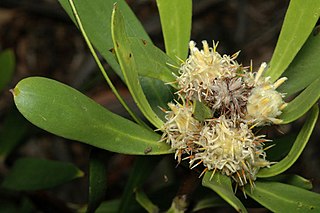
Isopogon, commonly known as conesticks, conebushes or coneflowers, is a genus of about forty species of flowering plants in the family Proteaceae, and are endemic to Australia. They are shrubs with rigid leaves, bisexual flowers in a dense spike or "cone" and the fruit is a small, hairy nut.

Isopogon dawsonii, commonly known as the Nepean conebush, is a shrub of the family Proteaceae and is endemic eastern to New South Wales. It has pinnate leaves with narrow segments and spherical heads of creamy yellow to greyish white flowers.

Isopogon formosus, commonly known as rose coneflower, is a species of flowering plant in the family Proteaceae and is endemic to the south-west of Western Australia. It is a shrub with divided leaves with cylindrical segments, and spherical to oval heads of pink or red flowers.

Isopogon dubius, commonly known as pincushion coneflower, is a species of plant in the family Proteaceae and is endemic to the south-west of Western Australia. It is a shrub with sharply-pointed, deeply lobed or pinnate leaves and more or less spherical heads of pink to reddish pink flowers.

Isopogon sphaerocephalus, commonly known as drumstick isopogon or Lesueur isopogon, is a species of plant in the family Proteaceae and is endemic to the south-west of Western Australia. It is a shrub with linear to narrow egg-shaped leaves and spherical heads of hairy white to creamy yellow flowers.

Isopogon adenanthoides, commonly known as the spider coneflower, is a plant in the family Proteaceae and is endemic to the southwest of Western Australia. It is an erect shrub with sharply-pointed, trifid leaves and spherical heads of pink flowers.

Isopogon fletcheri, commonly known as Fletcher's drumsticks, is a species of plant in the family Proteaceae and is endemic to a restricted area in the Blue Mountains of New South Wales. It is a bushy shrub with narrow egg-shaped to narrow lance-shaped leaves with the narrower end towards the base, and top-shaped to egg-shaped heads of yellowish or creamy green flowers.

Isopogon attenuatus is a species of plant in the family Proteaceae and is endemic to the south-west of Western Australia. It is a shrub with oblong to spatula-shaped or linear leaves and spherical heads of yellow flowers.

Isopogon axillaris is a species of plant in the family Proteaceae and is endemic to the south-west of Western Australia. It is a shrub with thick, linear to lance-shaped leaves with the narrower end towards the base and oval heads of pink or purple flowers.

Isopogon mnoraifolius is a shrub of the family Proteaceae and is endemic to New South Wales.

Isopogon petiolaris is a species of plant in the family Proteaceae and is endemic to eastern Australia. It is a low, spreading shrub with sharply-pointed, divided leaves and more or less spherical heads of yellow flowers.

Isopogon uncinatus, commonly known as Albany cone bush, is a species of flowering plant in the family Proteaceae and is endemic to a restricted area near Albany in Western Australia. It is a small shrub with very short stems, linear to egg-shaped leaves with the narrower end towards the base, and spherical heads of yellowish flowers. It is the rarest isopogon and was thought to be extinct until rediscovered in the 1980s.

Isopogon teretifolius, commonly known as nodding coneflower, is a species of flowering plant in the family Proteaceae and is endemic to the southwest of Western Australia It is an erect shrub with cylindrical, sometimes branched leaves, and flattened-spherical heads of hairy pinkish flowers.

Isopogon spathulatus is a species of flowering plant in the family Proteaceae and is endemic to south-western Western Australia. It is a shrub with linear to egg-shaped leaves with the narrower end towards the base, and more or less spherical heads of hairy pink flowers.

Isopogon polycephalus, commonly known as clustered coneflower, is a species of plant in the family Proteaceae and is endemic to the South coast of Western Australia. It is a spreading shrub with linear to lance-shaped leaves with the narrower end towards the base, and clusters of more or less spherical heads of white, cream-coloured or yellow flowers.

Isopogon crithmifolius is a species of plant in the family Proteaceae and is endemic to the south-west of Western Australia. It is a shrub with divided leaves and more or less spherical heads of glabrous reddish pink flowers.

Isopogon longifolius is a species of flowering plant in the family Proteaceae and is endemic to the southwest of Western Australia. It is a shrub with simple, linear, or deeply divided leaves and sessile, spherical heads of silky-hairy, yellow flowers and spherical to oval cone.

Isopogon scabriusculus is a species of flowering plant in the family Proteaceae and is endemic to southwestern Western Australia. It is a shrub with cylindrical, or narrow flat, sometimes forked leaves, and spherical to oval heads of pink or red flowers.

Isopogon tridens, commonly known as the three-toothed coneflower, is a species of flowering plant in the family Proteaceae and is endemic to the southwest of Western Australia. It is a shrub with wedge-shaped leaves with two or three sharply-pointed teeth, and flattened-spherical heads of glabrous creamy white, sometimes purple flowers.

Isopogon inconspicuus is a plant in the family Proteaceae and is endemic to the southwest of Western Australia. It is a small shrub with pinnate leaves with cylindrical leaflets, and pink to purple flowers covered with grey hairs.























